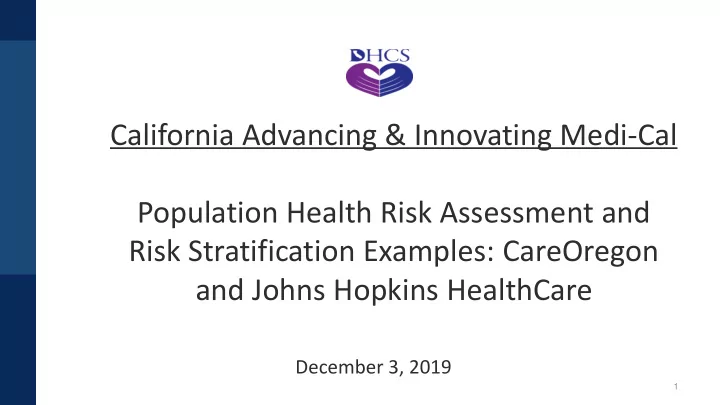

California Advancing & Innovating Medi-Cal Population Health Risk Assessment and Risk Stratification Examples: CareOregon and Johns Hopkins HealthCare December 3, 2019 1
CareOregon: Background • Oregon Medicaid Population Health requirements: – Individual health risk screens of all members – Share risk stratification and member characteristic data with providers in VBP arrangements • CareOregon background: – Managed Care Organization serving 250,000 Medicaid and Medicare beneficiaries across urban and rural Oregon 11/26/2019 2
CareOregon Health Risk Screening • Approach: – 10 question screening tool that focuses on physical, behavioral and oral health needs; food insecurity; ADLs; housing stability; and interest in/connections to care coordination services. – Administer via mail, phone, patient portal, community events, etc. • Successes: – Appropriate number of questions – Driving important conversations around standardized intervention protocols. • Challenges: – Incorrect or incomplete submissions – Data entry burden – Data architecture/interoperability barriers 11/26/2019 3
CareOregon Risk Stratification Approach Data Source Input Variables Cluster Algorithm Output 4 Medical Claims Age, ED Visits, Inpatient Analysis Admissions, Outpatient Other Visits Pharmacy Pharmacy Cost, Other Claims Derived Variables ACG Chronic Condition Count, Hospital Dominant Count, Major ADG Count, Diagnoses Used, Active Ingredient Count, Total Providers Seen Human assigned Labels 11/26/2019
Segments Healthy Healthy Healthy Kids Adults Total CareOregon Population Acute Moms Kids & & Low Risk *Utilization patterns of members/patients Adults Babies *Provides framework for how to Uncoord Chronic communicate and match the correct inated Managed intervention with the need Rising Risk Chronic Complex Uncoor- Managed dinated High Rx Extremely High Risk SA/SMI/ Complex Chronic
Johns Hopkins HealthCare: Background • Maryland Medicaid Population Health requirements: – No requirements around conducting health risk screenings – Requirements to identify special needs populations and populations who require care management • Johns Hopkins HealthCare background: – Managed care organization with Medicaid, Medicare Advantage, and commercial lines – 300,000 beneficiaries across Maryland – NCQA accredited 11/26/2019 6
Johns Hopkins Screening and Risk Stratification Approach • Screening: – Administered for certain health education programs and specific populations (e.g. pregnant women) • Risk Stratification Approach: – Used to identify patients for Complex Care Management and disease management programs – Id’d based on ACGs, authorizations, lab data, pharmacy data, and EHR data – Also look to state-wide health exchange and disease registries for additional information 11/26/2019 7
impairment, fall risk, difficulty walking, decubitus ulcer, social support needs) Possession Ratio Indicates whether a person has an unlikely (U), possible (P), or likely (L) coordination issue (CI). Based on 5 coordination markers, including number of management visits, level of provider participation in care, and provider, specialist, and generalist counts. LCI indicates 7+ unique providers, and PCI includes 2-6 unique providers plus other coordination risk markers. Medication (MPR) Coordination MPR represents the average supply days over the prescribing period. An MPR < .80 indicates low medication adherance for any of the following conditions: asthma, diabetes, CHF, HTN, IHD, disorders of lipid metabolism, depression, bipolar, schizophrenia Frailty Yes/No field indicating whether a patient has a diagnosis representing a medical problem associated with frailty (i.e., dementia, malnutrition, incontinence, vision Risk non-user and 5 = high resource user resource use, medication patterns, and special population markers) Band (RUB) Resource Utilization markers, resource use, medication patterns, and special population markers) following year, based on risk factors (i.e., age, gender, disease burden, disease Predicted probability (from 0 to 1) that the patient will be hospitalized in the Inpatient Admission Probability of Concurrent relative resource use categorized from 0 to 5, where 0 = year, based on risk factors (i.e., age, gender, disease burden, disease markers, Predicted probability (from 0 to 1) that the patient will be high cost in the following High Total Cost Probability of Definition ACG field ACG Fields Used for Risk Stratification 11/26/2019 8
Johns Hopkins Risk Stratification • Successes: – NCQA requirements – Using ACG system as backbone – Focusing risk assessment efforts on specific subpopulations in need of care management and/or with high needs • Challenges: – Lack of BH data – Difficult to risk stratify if don’t have claims data 11/26/2019 9
Questions? 11/26/2019 10
Recommend
More recommend